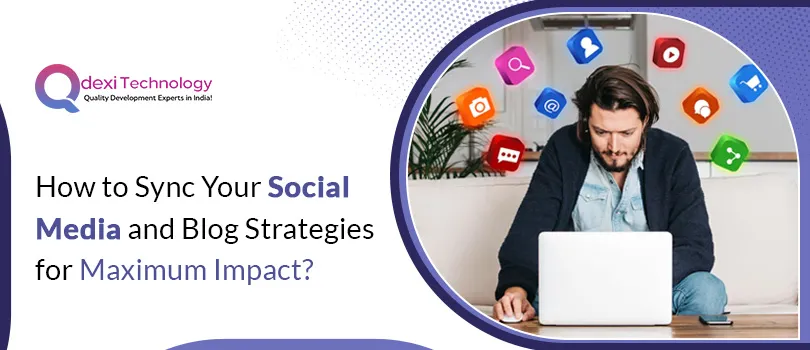In today's digital age, both blogs and social media are key components of any successful online marketing strategy. However, too many businesses miss the opportunity to align these two channels, ultimately missing out on their full potential. By syncing your social media and blog strategies, you can create a cohesive, impactful marketing approach that maximizes engagement, drives traffic, and amplifies your brand presence. Here’s how to synchronize your social media and blog efforts for maximum impact.
1. Understand Your Audience and Create a Unified Message
The first step in aligning your social media and blog strategies is to understand your audience. Whether you’re targeting millennials, professionals, or entrepreneurs, the content you share on both platforms should speak directly to their needs, interests, and behaviours. This alignment ensures that you aren’t duplicating content but rather creating a consistent narrative across both your blog and social channels.
To make this work, consider using insights from your social media analytics to shape the topics and tone of your blog posts. Social media promotion services often provide detailed analytics, which can help you identify trends, peak engagement times, and popular content themes. Use this data to craft blog posts that are both informative and aligned with your audience's expectations.
2. Repurpose Blog Content for Social Media
A great way to sync your blog and social media strategies is by repurposing blog content for your social platforms. After writing a blog post, break it down into smaller, bite-sized content pieces, such as:
- Quotes or excerpts: Share thought-provoking quotes or snippets from your blog post as social media posts. This can spark curiosity and direct users to your blog for more.
- Infographics or images: Visual content tends to perform well on social media, so turn key points from your blog into eye-catching graphics or infographics.
- Teaser posts or summaries: Post a short summary or teaser that piques interest and directs followers to read the full article on your blog.
Repurposing blog content not only increases its lifespan but also ensures you’re engaging with your audience across multiple touchpoints. A social media services company can help you streamline this process, enabling you to post consistently while ensuring that your content resonates with your target audience.
3. Use Social Media to Drive Traffic to Your Blog
Your blog should act as the central hub of your content strategy, and social media is an ideal tool to drive traffic to it. With each new blog post, share a link to it across your social media profiles. Be sure to create compelling captions and calls to action that encourage your followers to click the link and read more.
If you're leveraging a social media SEO service, make sure your blog posts are optimized for both social sharing and search engines. This means using appropriate keywords, including hashtags, and creating engaging descriptions that prompt interaction. A good SEO strategy will improve the chances of your blog post being discovered through social media search features, driving more traffic and engagement.
4. Engage with Your Audience on Both Platforms
Syncing your blog and social media efforts isn't just about content; it's also about engagement. After sharing a blog post, take time to respond to comments, questions, and feedback across your social media channels. Engaging with your audience builds trust and helps to humanize your brand, which can lead to increased loyalty and conversions.
Encourage social media followers to leave comments on your blog posts by asking questions, running polls, or sharing opinions. Likewise, use your blog to invite readers to follow you on social media for more updates, news, and behind-the-scenes content. This two-way engagement creates a seamless flow between your blog and social media accounts, enriching both platforms.
5. Monitor and Adjust Based on Analytics
Successful content strategies rely heavily on data. By regularly monitoring analytics from both your blog and social media platforms, you can gain valuable insights into what’s working and what’s not. Tools like Google Analytics for blogs and the analytics tools offered by most social media platforms can show you which content resonates best with your audience.
By analyzing metrics like traffic sources, user engagement, and post-performance, you can adjust your strategy to improve outcomes. For instance, if a blog post is driving a lot of traffic from Facebook but not from Twitter, you might decide to tailor your content more specifically for the Twitter audience.
Working with a social networking application development service can also help you streamline data integration across platforms, providing more effective tools to track, analyze, and refine your marketing strategy.
6. Consistent Branding Across Both Channels
To create a strong brand presence, it’s crucial to maintain consistency across both your blog and social media channels. This includes using the same logo, color scheme, voice, and tone in both places. Consistent branding builds trust with your audience, making it easier for them to recognize your brand at a glance.
From blog post titles to social media captions, ensure that your message aligns across platforms. A cohesive brand presence will lead to higher engagement rates and greater brand recall.
Conclusion
Syncing your social media and blog strategies for maximum impact requires a thoughtful approach, but the payoff is worth it. By understanding your audience, repurposing content, driving traffic from social media, engaging with your followers, and using data to adjust your strategy, you can create a seamless experience that nurtures relationships and boosts your brand’s visibility. Whether you’re leveraging social media promotion services or working with a social media services company, aligning your content across both channels can significantly enhance your online presence and business growth.
Remember, the key to success lies in the harmony between your blog and social media, creating a unified strategy that resonates with your audience at every touchpoint.






